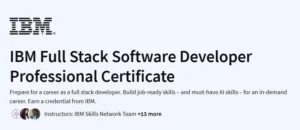What will you learn in Make Your Own Neural Network in Python Course
Understand the mathematical foundation behind neural networks.
Implement a basic neural network from scratch using only Python and NumPy.
Learn how forward propagation, backpropagation, and weight updates work.
Train a neural network to classify handwritten digits from the MNIST dataset.
Gain practical knowledge of activation functions, learning rates, and error metrics.
Build foundational skills to transition into deep learning and AI frameworks like TensorFlow or PyTorch.
Program Overview
Module 1: Introduction to Neural Networks
⏳ 1.5 hours
Topics: Biological vs. artificial neurons, history and significance of neural networks.
Hands-on: Visualize how data is transformed in layers of a simple network.
Module 2: Math Behind Neural Nets
⏳ 2 hours
Topics: Matrix operations, dot product, sigmoid function, and gradient descent.
Hands-on: Manually compute forward and backward passes with NumPy.
Module 3: Forward Propagation
⏳ 1.5 hours
Topics: Input to hidden layer to output transformations, activation functions.
Hands-on: Code a single-layer neural network with Python arrays.
Module 4: Backpropagation and Weight Updates
⏳ 2.5 hours
Topics: Loss functions, delta rule, partial derivatives, learning rate.
Hands-on: Implement backpropagation to optimize the network’s weights.
Module 5: MNIST Dataset Classification
⏳ 3 hours
Topics: Preprocessing images, feeding real data into a neural net.
Hands-on: Build a working digit recognizer using your own neural network.
Module 6: Tuning and Optimization
⏳ 2 hours
Topics: Hyperparameters, performance tracking, epochs, overfitting basics.
Hands-on: Adjust learning rates, hidden units, and layers to improve accuracy.
Get certificate
Job Outlook
Neural networks form the backbone of deep learning, powering AI in healthcare, finance, and more.
Skills in neural net fundamentals are highly valuable for roles in machine learning and AI engineering.
Excellent stepping stone for advanced frameworks like TensorFlow, Keras, or PyTorch.
Prepares learners for roles like data scientist, ML engineer, AI researcher, or algorithm developer.
Specification: Make Your Own Neural Network in Python Course
|
FAQs
- Only basic algebra and matrix operations are needed.
- The course explains core math like dot products and gradient descent step-by-step.
- You don’t need prior calculus expertise; concepts are introduced practically.
- Visual explanations make math more intuitive.
- External resources can be consulted if you want deeper math theory.
- Yes, it builds the foundation for advanced AI frameworks like TensorFlow and PyTorch.
- You’ll understand how algorithms work under the hood, avoiding “black box” reliance.
- The skills apply to classification tasks like image or text recognition.
- You can extend the codebase to bigger datasets beyond MNIST.
- It’s a stepping stone to deep learning specializations and AI engineering roles.
- Basic knowledge of Python syntax is recommended (loops, functions, arrays).
- No prior AI or machine learning coding experience is required.
- NumPy is introduced gradually for matrix operations.
- Code examples are broken down into small, digestible parts.
- Even if you’re new, consistent practice will help you keep up.
- The course focuses only on small-scale networks for learning purposes.
- It does not cover GPU acceleration or large deep learning models.
- Optimization is shown through learning rates, epochs, and simple tuning.
- For large-scale AI, you’ll need to transition into frameworks like PyTorch or TensorFlow.
- The course ensures you understand the basics so scaling later feels natural.
- Provides a strong foundation for machine learning and AI engineering roles.
- Helps prepare for advanced certifications in AI, ML, or data science.
- Understanding neural networks is useful in industries like healthcare, finance, and automation.
- Employers value candidates who know the “why” behind algorithms.
- It’s a useful portfolio project for resumes and interviews.





